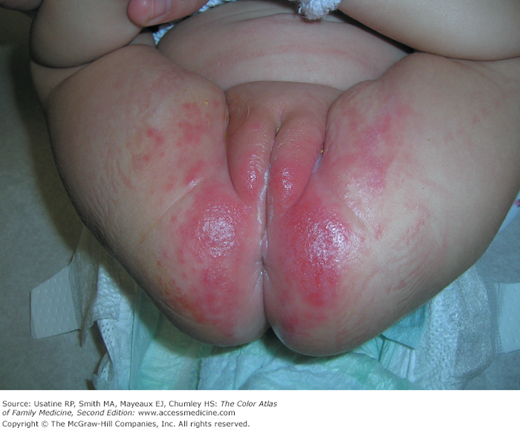Patient Story
A 2-month-old baby girl was brought to the office with a severe diaper rash that was not getting better with Desitin. Upon examination, the physician noted a white coating on the tongue and buccal mucosa. The diaper area was red with skin erosions and satellite lesions (Figure 111-1). The whole picture is consistent with candidiasis of the mouth (thrush) and the diaper region. The child was treated with oral nystatin suspension and topical clotrimazole cream in the diaper area with good results.
Introduction
Epidemiology
- Diaper dermatitis is the most common dermatitis of infancy.
- Variability in prevalence of 4% to 35% among children in their first 2 years of life in different studies.1
- Diaper rash is thought to be present in 25% of children presenting for outpatient visits.2
- No differences in prevalence between genders or among ethnic groups.
- One study showed an incidence of 19.4% in children ages 3 to 6 months.1
- Higher incidence among formula-fed compared with breastfed infants.1
- Condition typically begins around age 3 weeks, peaks at age 9 to 12 months, and then decreases with age until it resolves completely with toilet training.
- Individual episodes last from 1 day to 2 weeks.
- Aggravating factors include poor skin care, diarrhea, recent antibiotic use, and urinary tract abnormalities.
- Perianal streptococcal dermatitis occurs in children between 6 months and 10 years of age (Figures 111-2 and 111-3).
Etiology and Pathophysiology
- Primary diaper dermatitis—An acute skin inflammation in the diaper area with a multifactorial etiology.3 The main cause is irritation of thin skin as a result of prolonged contact with moisture including feces and urine. The multiple factors involved are:
Occlusion/lack of exposure to air.
Friction and mechanical trauma.
Local irritants—Fecal proteases and lipases.
Increased pH.
Maceration of the stratum corneum with loss of the protective barrier function of skin.
- Irritant diaper dermatitis (IDD) is a combination of intertrigo (wet skin damaged from chafing) and miliaria (heat rash) when eccrine glands become obstructed from excessive hydration. It is a noninfectious, nonallergic, often asymptomatic contact dermatitis that typically lasts for less than 3 days after a change in diaper practices.
- Candidal diaper dermatitis—Within 3 days, 45% to 75% of diaper rashes are colonized with Candida albicans of fecal origin.
- Bacterial diaper dermatitis may be a secondary infection caused by Staphylococcus aureus or Streptococcus pyogenes. Other common bacterial isolates include Escherichia coli, Peptostreptococcus, and Bacteroides. Usually occurs during the warm summer months.
- Perianal streptococcal dermatitis is caused by group A β-hemolytic streptococci (Figures 111-2 and 111-3).
Risk Factors
Diagnosis
- IDD begins with shiny erythema with or without scale and poorly demarcated margins on the convex skin surfaces in areas covered by diapers. Moderate cases can have papules, plaques, vesicles, and small superficial erosions that can progress to well-demarcated ulcerated nodules typically with sparing of skin folds (Figure 111-4).
- Pustules or papules beyond the rash border (called “satellite lesions”), involvement of the skin folds, and white scaling all indicate a fungal infection with Candida

Stay updated, free articles. Join our Telegram channel

Full access? Get Clinical Tree





